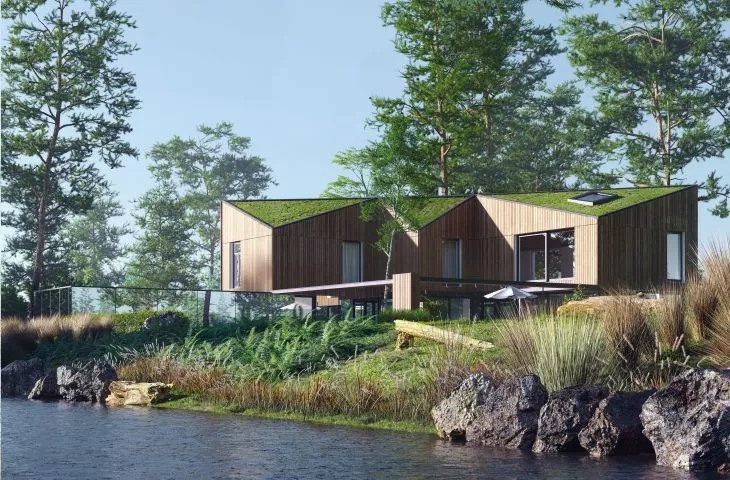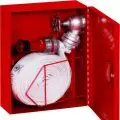An unusual shape, mirror-like sheet metal reflecting the green surroundings and a sloping roof with three pitches are the characteristics of the Mirror House designed by TRINN studio architects.
The single-family house is being built on a large, open, green and well-sunlit plot near Gdansk. The architects, wanting to maintain the character of the surroundings, decided to use mirrored sheets on the first floor elevation. This treatment made the upper part of the house seem to levitate above the ground, without obscuring the surrounding space. The front elevation, on the other hand, was designed in a very simple form in opposition to the garden elevation, which is divided into three parts. A green sloping roof with three gently different pitches optically reduces the building from the leisure side. In the interior, the living areas were connected by a common outdoor terrace closed with an I-beam.
On the garden side, three truncated green roofs were created
© TRINN
Dobrawa Bies: What was the main inspiration for the project, what is the shape of the block derived from?
Michal Ostafijczuk: When designing single-family houses, most often in our case the biggest inspiration and guideline that gives direction is the plot itself, and this was also the case here. A small pond and a lot of existing greenery, which we wanted to enhance, contributed to the visible solutions. The use of mirrored sheet metal in the first floor portion of the facade and wood above, depend on two clues we received from the site where we were to design the building. The first, of course, is the desire to reflect as much greenery around as possible - standing in front of the house, we have the impression as if the house is levitating above the surrounding nature.
The second was the very structure of the pine trees growing in the area, i.e. the very high root neck, which in our design is a mirror, and the crown is the wooden facade of the house. As for the upper wooden part of the house - from the front, we elevated one of the tops upwards, so as to create a mini mezzanine in the corner room and further make the mass more dynamic. From the garden, on the other hand, three beveled green roofs were created to cover each room.
Dobrawa Bies: What was your priority in this project?
Michal Ostafijczuk: The priority was definitely to enhance the greenery surrounding the house, as well as to design a tall, spacious living area with a mezzanine, which was the investors' guideline. We didn't want to design a white spot that would artificially shine on the plot. The goal was actually to design a reflection of the surroundings.
The mirrored sheet adds lightness and visually lifts the house
© TRINN
Dobrawa Bies: What were the investors' expectations?
Michal Ostafijczuk: The investors approached us with a desire to design a house for a family of three. The inspiration they presented revolved around Scandinavian architecture, wooden houses in forests, warm, cozy interiors and intimate terraces. We believe that we fully succeeded in transforming these expectations into a very well-designed, original building fully integrated into the surroundings.
Dobrawa Bies: What posed the greatest design difficulties, and what are you most satisfied with?
Michal Ostafijchuk: Actually, the only challenge was to convince the investors of the mirrored sheet metal. Once we succeeded, it was this fact that gave us the most joy, because we achieved the visual effect we really wanted. And it's not always that investors are willing and brave enough to fully trust architects.





























